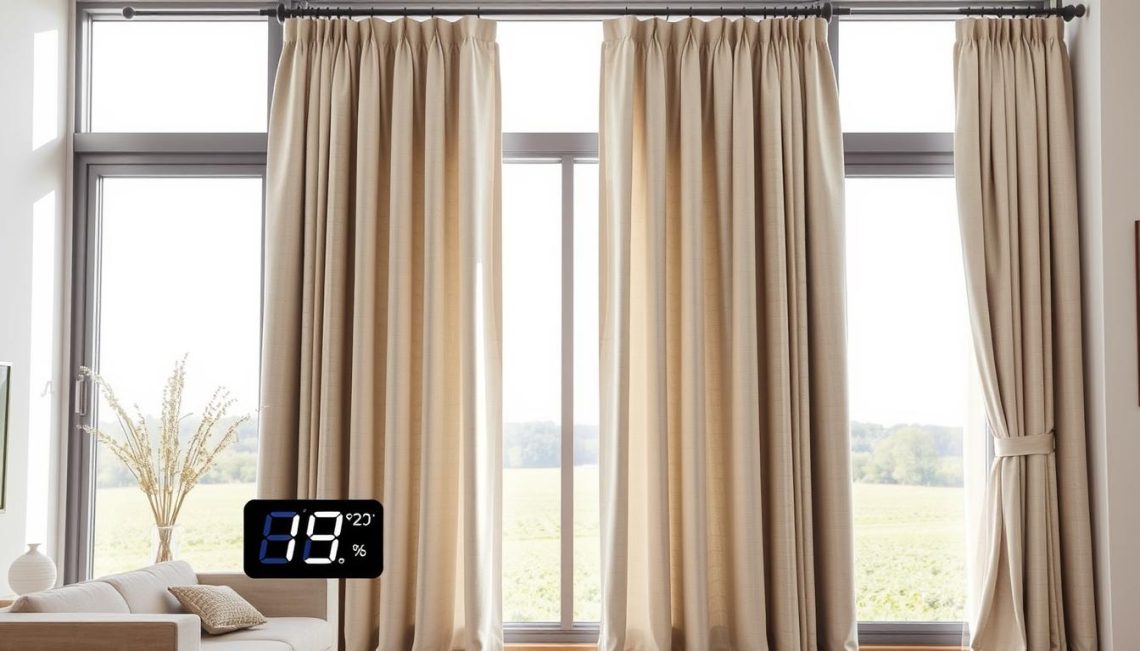As we explore ways to enhance our homes’ energy efficiency, a common question arises: can thermal curtains really make a difference? Thermal curtains are designed to keep warmth in and cold out, or vice versa, depending on the season.
By reducing heat transfer through windows, these curtains can potentially lower energy bills and improve overall comfort within our living spaces. But how effective are they, really?
We’ll examine the benefits and functionality of thermal curtains, providing insights into their role in enhancing energy efficiency in homes.
What Are Thermal Curtains?
Thermal curtains are an innovative solution for home insulation. They are designed to help regulate the temperature inside your home by reducing heat transfer through windows. We find that using thermal curtains can significantly improve the energy efficiency of our homes.
The Structure and Materials of Thermal Curtains
Thermal curtains are made with materials that have high thermal insulation properties. Typically, they consist of multiple layers, including a thick, heavy fabric that helps to block heat transfer. The materials used are often durable and designed to last, making them a practical choice for window treatments.
Different Types of Thermal Window Treatments
There are various types of thermal window treatments available, catering to different needs and preferences. Some popular options include blackout curtains, which not only provide insulation but also block out light, and cellular shades, which trap air to keep warmth in. We can choose from a range of styles and materials to suit our home decor and insulation requirements.
Do Thermal Curtains Work? The Science Explained
To comprehend how thermal curtains work, it’s essential to examine the principles behind their thermal insulation properties. Thermal curtains are designed to provide a barrier against heat transfer, helping to maintain a consistent indoor temperature.
How Thermal Curtains Block Heat Transfer
Thermal curtains achieve their insulating effect primarily through their material composition and thickness. By using materials with low thermal conductivity, these curtains minimize heat transfer between the window and the interior space, thus reducing heat loss in winter and heat gain in summer.

Temperature Regulation Capabilities
The ability of thermal curtains to regulate temperature is crucial for maintaining a comfortable indoor environment. By reducing heat transfer, they help keep homes warmer in the winter and cooler in the summer, enhancing overall energy efficiency.
Additional Benefits: Noise Reduction and Light Blocking
Beyond their thermal benefits, thermal curtains also offer additional advantages, including noise reduction and light blocking. The dense materials used in thermal curtains can effectively dampen external noise and block out sunlight, creating a more peaceful and private indoor space.
How to Choose and Install Thermal Curtains
To get the most out of your thermal curtains, you need to select the right type and install them correctly. This involves considering several factors, including the type of window, the climate, and your personal preferences.
Selecting the Right Thermal Curtains for Your Needs
When selecting thermal curtains, consider the type of window you have and the level of insulation you need. Different types of thermal curtains are available, including blackout curtains, thermal insulated curtains, and cellular shades.
Proper Measurement and Installation Techniques
To ensure a proper fit, measure your windows carefully before ordering thermal curtains. Installation is also crucial; make sure to follow the manufacturer’s instructions for hanging and securing the curtains.
Best Practices for Maximum Efficiency
To maximize the efficiency of your thermal curtains, keep them clean and dust-free. Also, consider using curtain ties or hooks to keep the curtains open during the day, allowing sunlight to warm your rooms.
Getting the Most Value from Your Thermal Curtains
To maximize the energy efficiency of your thermal curtains, regular maintenance is essential. We recommend dusting them periodically to ensure they continue to function optimally.
Using thermal curtains in conjunction with other window treatments can further enhance their effectiveness. For instance, layering them with other energy-saving window treatments can help to reduce heat transfer and keep your home cozy.
Assessing the effectiveness of your thermal curtains is also crucial. By monitoring your energy consumption before and after installation, you can determine the impact they’ve had on your energy efficiency. This will help you make informed decisions about your window treatments and identify areas for further improvement.
By following these tips, you can get the most value from your thermal curtains and enjoy a more energy-efficient home. Effective window treatments play a significant role in maintaining a comfortable indoor climate while reducing energy costs.
